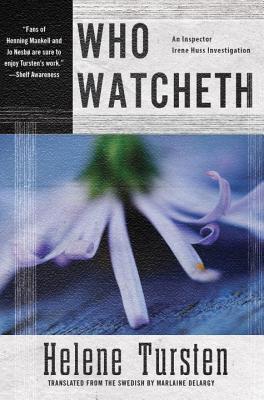 Who Watcheth by Helene Tursten, Marlaine Delargey
Who Watcheth by Helene Tursten, Marlaine Delargey Formats available: hardcover, ebook
Series: Inspector Huss #9
Pages: 304
Published by Soho Crime on December 6th 2016
Publisher's Website, Amazon, Barnes & Noble, Kobo, Bookshop.org
Goodreads
He watches the women from the shadows. He has an understanding with them; as long as they follow his rules, they are safe. But when they sin, he sentences them to death. A woman is found dead in a cemetery, strangled and covered in plastic. Just a few days before her death, the victim had received a flower, an unintelligible note, and a photograph of herself. Detective Inspector Irene Huss and her colleagues on the Goteborg police force have neither clue nor motive to track in the case, and when similar murders follow, their search for the killer becomes increasingly desperate. Meanwhile, strange things have been going on at home for Irene: first the rose bush in her garden is mangled, then she receives a threatening package with no return address . . .
My Review:
The title of this suspense thriller is a play on a very old Latin quotation: Quis custodiet ipsos custodes?, literally translated as “Who will guard the guards themselves?” That meaning is only part of the story in Who Watcheth. In this case it also carries the connotation of watching from the shadows. In other words, stalking.
And while the stalker from the shadows forms the bulk of this case, in the end, the question of “who guards the guards?” is the one that is left hanging in the reader’s mind, quivering with possibility. And tragedy.
The story here is one that has been told before, in multiple suspense thrillers. There’s a serial killer on the loose. At first the police, in the person of Detective Inspector Irene Huss, don’t know that the murders of women in their 40s are connected. But as the bodies begin to stack up, the investigators hunt both backwards and forwards, to see if they can determine where the crime spree began, and try to zero in on the man the newspapers are calling “the Package Killer” for the way he leaves his victims neatly bundled up.
The conundrum for the investigators is that the killings appear random. The victims are roughly the same age, and are all unmarried, but otherwise they don’t seem to have much in common. It’s begins to seem as if they all work or at least shop at the same mall, but then, so do thousands of other people. It’s not much of a link.
And it doesn’t help them even when they zero in on a possible suspect. Daniel Borjesson is seriously creepy, but creepiness alone is not a crime. Unfortunately. He gives everyone who deals with him a serious case of the heebie-jeebies, and with good reason. But as much as the man touches off every single investigator’s gut instincts, no one can find a real connection between Borjesson and any of the victims, nor can they find any evidence that the man has access to either the car necessary for transporting his victims or the secure and out-of-the-way premises required to prepare his “packages” so meticulously.
Cop shop politics and the bureaucratic obsession with finances force the detectives to let him go. Their mistake is going to be extremely costly in the end. But for whom?
Escape Rating B+: This is a chilling thriller. It is also a very compelling read. I kept going long after the lights were out, which is a mistake. While this isn’t gory, the atmosphere of creeping menace makes for a tough read when the only light in the house is your iPad. But I absolutely had to finish.
This is the 9th book in the Inspector Huss series and is also part of the current wave of Scandinavian crime fiction. My exposure to that particular wave consists of seeing a few Wallander episodes, and this was my first introduction to Huss, but I still enjoyed the book a great deal, and didn’t feel like I was missing anything by not having read the rest of the series.
On that other hand, the atmosphere of the cop shop and Huss’ relationship with her family reminded me surprisingly of the J.D. Robb In Death series. The investigator’s personal life does find echoes and resonances in her cases, and there are bits about the cop shop and the group dynamics that felt similar across time, place and culture.
In the end, whodunnit is not a surprise to the reader. Much of the compulsion in the narrative revolves around putting the pieces together, and whether the detectives will manage to do so in time. Before the killer strikes again.
And the ending is a stunner.
